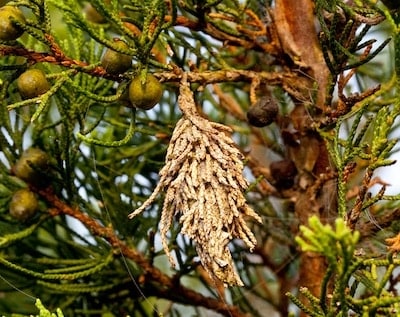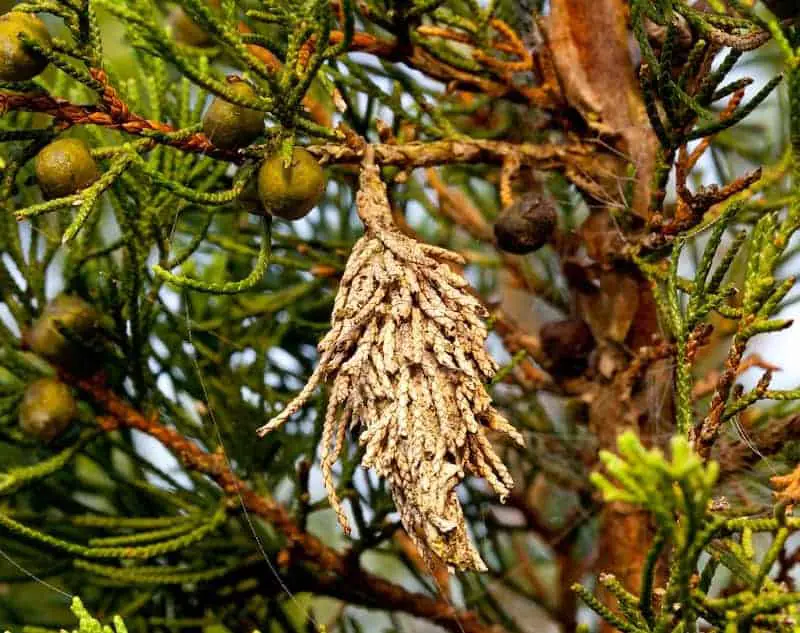The Best Ways to Get Rid of Bagworms
If you’ve noticed a yellowing of the leaves on your trees and shrubs or significant defoliation, you may have a bagworm infestation. Unfortunately, your problem can already be out of control by the time you realized you even have a problem. To help you save your trees and plants, I’ve put together a treatment guide on how to get rid of the bagworms and prevent them from coming back in the future!
How do you get rid of bagworms? The truth is, the most effective way to get rid of bagworms is to thoroughly inspect your plants for signs of infestation, particularly during the fall or winter. But, if this is not possible, there are a few treatments you can implement to help reduce their number. These treatments include:
- Seasonal Inspection
- Handpicking
- Introducing Natural Predators – Biological Control
- Insecticide Spray – Chemical Control
Bagworm infestations are a challenge to control and eradicate, but if you’re willing to do the dirty work and take the time, you will be able to save your trees and plants. Let’s dive into what these little pests are and why they are so destructive, then we’ll discuss how to get rid of them!
What Is a Bagworm – Behavior, Diet, & Habits
Bagworms follow a four-stage life cycle: egg, larvae, pupae, adult. The adult females will lay eggs inside her bag, from 300 to 1,000 eggs at a time, where they will reside and grow during winter.
Life Cycle
Once Spring hits, the eggs will hatch and each larva will create its own encasing that grows as they do. After the larval stage, the insect enters the pupae stage where they stay in the bag until they are adults. As adults, the males have wings and will fly to where the females are for mating – the females do not have wings and will not leave the bag they built after hatching.
Food Source
Bagworms feed on a steady diet of plant needles or leaves of various types of trees. It is most common for bagworms to feed on cedar trees, but other common types are arborvitae, deciduous, Juniper, Pine, and Spruce.
Appearance & Where to Find Them
 Immature bagworms are grayish in color, with the males having wings and the females being worm-like. You can find bagworms in the tree trunk, the limbs of the tree, and the foliage of the tree or other plants.
Immature bagworms are grayish in color, with the males having wings and the females being worm-like. You can find bagworms in the tree trunk, the limbs of the tree, and the foliage of the tree or other plants.
If you have a large infestation, you will see multiple bags that are relatively large in size – they grow the more the larvae feed.
Now that you understand how to determine if you have bagworms and what to expect from them, let’s talk about getting rid of them.
Seasonal Inspection
Home and garden professionals will tell you that inspecting your plants and tree for pests like bagworms is the best form of prevention and control. It is good to inspect throughout the year, but the best time is during late fall or winter. This is before the bagworms hatch and larvae begin to feed and disperse.
Make sure you are thorough in your search, determining whether the bags are new or old, and looking through the foliage where some bags may be hidden. You can always call a pest control professional to come out and check for you, especially if you already have them come spray your yard for other pests.
Handpicking
The reason for inspecting during the late fall and winter is because this is also the best time to begin the “handpicking” treatment to get rid of the bagworms. You may not like this treatment very much because it requires you to get down and dirty, but it is very effective.
Handpicking is exactly as it sounds – you handpick the bags off of the trees. Once you remove the bags, you must submerge them in water to suffocate the larvae or destroy them completely.
You must do this before the eggs hatch and the larvae haven’t yet left the bags to feed. You should be sure to remove the silk as well so that it does not strangle new leaves on the tree.
Introducing Natural Predators – Biological Control
Sometimes handpicking is not always feasible – especially if you’re dealing with tall trees. If this is the case, you can always go the biological route. Introducing natural predators to a pest’s environment can be very effective at reducing their population, as well as preventing their return.
In the case of bagworms, birds and natural bacterias are both effective, natural predators. Sparrows and the bacteria Bacillus thuringiensis are both good sources to help drive away any bagworms from your plants and trees.
You can attract sparrows to your yard by placing birdbaths strategically, near affected trees, and providing materials for nesting and places for shelter. The bacteria Bacillus thuringiensis is most effective if applied immediately after the eggs hatch. It can be found at online retailers and comes with instructions on how to apply it.
Insecticide Spray – Chemical Control
Sometimes we are hesitant to use chemicals when trying to control pest issues, either because we are working to save the environment or we are worried about their effects on our family and pets. But, sometimes they are the best choice for saving our plant life.
Go to your local home and garden store and talk to an expert – they can help advise you on the type of spray you should use, how much you might need, or anything else that could help with the problem. They will also tell you it is better to spray in late Spring, just before the larvae have begun to feed.
Anytime you use a chemical product, you should always follow the instructions on how to apply it. Different sprays can be found online at places like Amazon or your local home and garden store.
Related Questions
Where did the bagworms come from?
Certain trees, like Cedar, attract bagworms, but it is more likely that they were introduced to your yard from nearby trees or brought in on new plants. When the eggs hatch, the larvae can and will crawl to nearby plants to feed. They also may spin a silk thread, which can catch in the wind and carry them to new trees.
It’s important that you diligently check your plants for anything resembling bagworms because their population can soar very quickly. So, if you’ve recently planted a new shrub, or are about to do some landscaping, be sure to check the plants thoroughly before bringing them home. Plant nurseries are typically good at doing this for you, but you can never be too careful!
Will bagworms kill a tree?
If left unchecked, a bagworm infestation can completely defoliate and kill, yes kill, your trees, bushes, hedges, and plant life. Bagworms are not threatening to human health but they can cause a lot of damage to the plants in your yard.
Can a tree recover from bagworms?
Trees can most certainly recover from bagworms – as long as you have destroyed the infestation and are watching for your tree’s regrowth. Evergreens seem to take longer to start the regrowth process after being attacked by bagworms, in this case fertilizing is helpful to stimulate new growth. Any limbs that you notice were defoliated and fail to recover the next Spring should be removed for the health of the rest of the tree.

